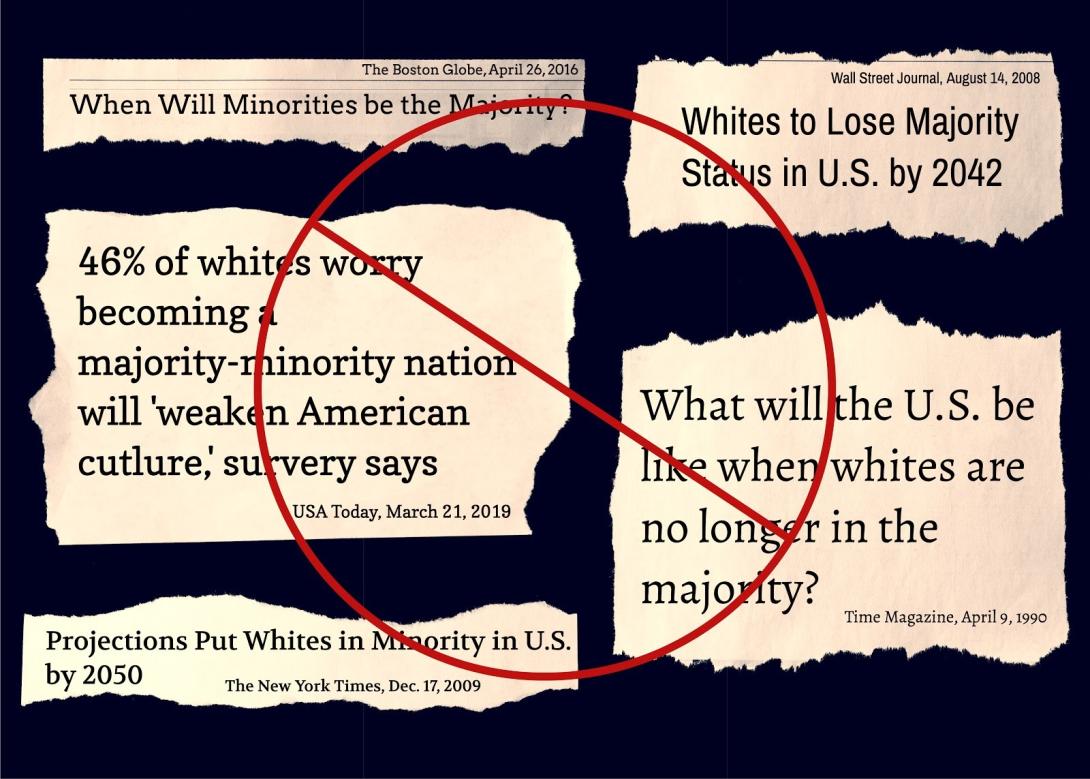The Misleading Narrative of a Disappearing White Majority

Categories that are inaccurate
For more than thirty years, media headlines have touted a population tipping point in which the white majority is overtaken numerically by minorities of all other races and ethnicities. These headlines are misleading. The “white” majority only seems to be disappearing because a growing number of white Americans are counted as minorities in many applications of census data. Two examples in the public sphere illustrate the point.
Consider actor Mark-Paul Gosselaar, for instance, best known as blonde haired heartthrob Zack Morris from the early-90s sitcom, Saved by the Bell. Most viewers would consider Gosselaar to be white. If Gosselaar, who once quipped, “People don’t know that Zack Morris is half Asian,” identified himself as both white and Asian on the Census, he would be tabulated by the Census as a person of “two or more races,” which is a category classified as a minority – thereby no longer counting him as white or Asian.
The same goes for Gilmore Girls’ star Alexis Bledel. While most people see the fair skinned, blue-eyed Bledel as white, according to the census categorization, she, too, would be in the minority category, because of her Hispanic heritage.

Gosselaar and Bledel are not alone. Anyone who does not identify as “white alone, non-Hispanic” in the U.S. Census is considered a minority in statistics as well as in most analyses of the racial composition of our population. As the number of white people who identify as more than one race (or as Hispanic) continues to grow, more people will be counted as minorities.
Birth data from 2018 underscores this trend. We examined the CDC’s 2018 U.S. birth data starting with parents’ race and ethnicity to get a glimpse of the racial composition of future generations of Americans. More than 40 percent of the 3.8 million total births in 2018 were to parents of different races/ethnicities* and over two-thirds of minority babies born in 2018 had one white parent. All of these babies would be classified as “two or more races” or “Hispanic” by the Census and, thereby as minorities.

The 2018 birth data shows us that the racial identity of a substantial share of the next generation of Americans will not easily fit into our current racial categories. This trend has been going on for decades. As long as we characterize those identifying as “two or more races” as “minority,” we will continue to feed the narrative that the white majority is disappearing.
Immigrants and native born
Our analysis of mothers’ immigrant status suggests that interracial unions will grow even more rapidly in the future. At present, among all races, Asian mothers have the lowest rates of interracial births. This is largely because a majority of Asians in the U.S. are foreign-born, who tend to either come to the U.S. with their partners, or find partners within the same race or country of origin. This is true among immigrant Hispanic mothers as well.
In contrast, among the 20 percent of Asian mothers who are U.S.-born, interracial births are actually quite high, nearly 50 percent. What this suggests is that when the large number of U.S.-born children of Asian or Hispanic immigrant parents grow up, they will be much more likely than their parents’ generation to assimilate into America’s patterns of interracial unions.
Compounding growth in interracial parentage
Finally, interracial/ethnic parents give births to interracial/ethnic children, leading to compounded growth in the part of the population characterized as “two or more races.” This growth will make it increasingly impossible to untangle racial identities for most Americans over the next 20 years and beyond, making it unwise to use current racial categories to describe the future population.
In the chart below, for each race category, a blue dot indicates the percent of that race alone in the overall U.S. population in 2018. An orange dot indicates the percent of the 2018 births of that race alone (non-Hispanic), and a white dot indicates the percent of the 2018 births of that race alone or in combination with other races or Hispanic.

As shown in the chart, the recent and current high rates of interracial childbearing will cause not only the share of the white-alone, non-Hispanic population to continue to decline in the future, but will introduce a decline in all other individual race groups, except potentially Asian Americans. For example, the high prevalence of Native Americans with a partner from a different race or ethnicity means that although Native Americans make up 0.9% of the U.S. population, only 0.3% of 2018 births were from two parents who were both Native American alone (and not Hispanic). Yet, the same birth data also shows that 1.2% of all U.S. children born in 2018 had at least one parent who was Native American. Should one use 0.3% or 1.2% when describing the change of this race group? Is it a decline or an increase when compared to the overall Native American population? Likewise, how do we characterize the change in the white population? While white alone individuals made up 72 percent of the population, 85% of births in 2018 were to white alone or in combination with other races or Hispanic and only 51% of births were to two parents who identified as white alone, non-Hispanic.
Time to change the narrative
In light of this shifting reality, it is important that the public and media move away from a “one-drop” style of narration that over-simplifies the diversifying process within racial and ethnic groups. Viewing “white-alone, non-Hispanic” as the core American racial composition may soon no longer be meaningful or valid. It distorts the identity of millions of Americans who see themselves white as well as Black, Asian, Native American, or Hispanic, or Black as well as white, American Indian, Hispanic, or Asian.
Since 2000, the census has taken steps to recognize the changing racial diversity of America by allowing the selection of more than one race. In the last 20 years, however, the tabulations of “race alone or in combination” were rarely used. Instead, the typical applications, projections, and narrations of race have continued to rely on the old “one race alone” categories, failing to capture this fast-evolving reality. Yet, despite the challenges of conveying the complexity of race in America, how we narrate this information matters. Studies have shown that apprehension over the perceived “white decline” has increasingly influenced how Americans vote as well as their view of society and the country’s future.
Next year, when the results of the 2020 Census are released, the media is likely to focus on the changes in population by race. Recognizing that the current way of defining and measuring majority and minority groups for the future population is likely to be considered outdated or even absurd by the future population, it is important to avoid such narratives now. It is worth noting that the typical tabulations of race lead not only to an undercounting of the white population, but to undercounting of all racial groups. Barack Obama and Kamala Harris are both prominent examples of the growing number of Black Americans who are excluded from population statistics for Black Americans, because they are not “Black alone.” Unless more inclusive definitions of race that accurately reflect the country’s makeup are used, the gap between the picture of the country that most racial statistics show and the reality we see in our everyday lives is only going to widen as the country grows more diverse.
___________
* Ethnicity is defined as “Hispanic” or “non-Hispanic,” and Hispanic can be of any race.


